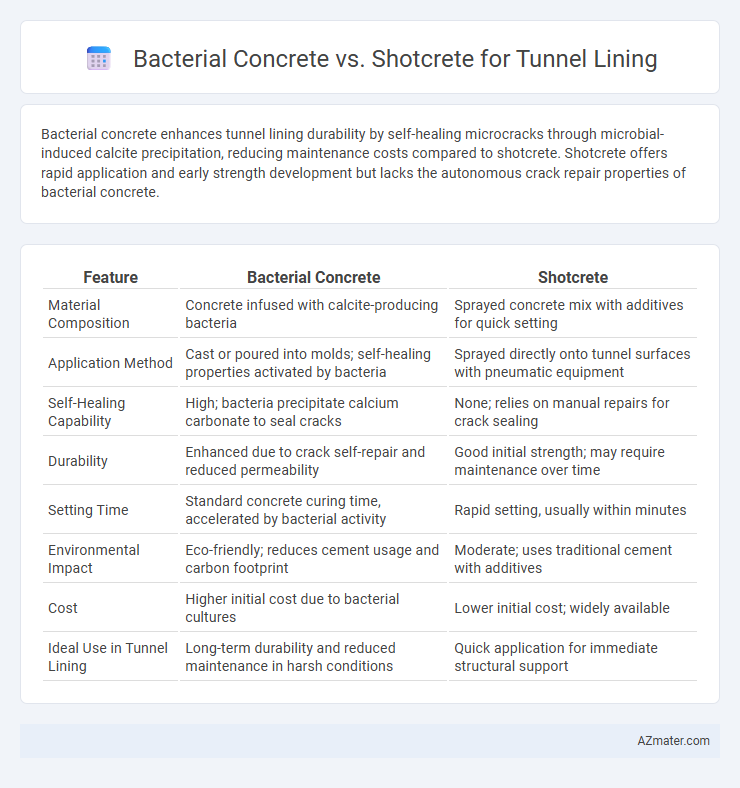Bacterial concrete enhances tunnel lining durability by self-healing microcracks through microbial-induced calcite precipitation, reducing maintenance costs compared to shotcrete. Shotcrete offers rapid application and early strength development but lacks the autonomous crack repair properties of bacterial concrete.
Table of Comparison
| Feature | Bacterial Concrete | Shotcrete |
|---|---|---|
| Material Composition | Concrete infused with calcite-producing bacteria | Sprayed concrete mix with additives for quick setting |
| Application Method | Cast or poured into molds; self-healing properties activated by bacteria | Sprayed directly onto tunnel surfaces with pneumatic equipment |
| Self-Healing Capability | High; bacteria precipitate calcium carbonate to seal cracks | None; relies on manual repairs for crack sealing |
| Durability | Enhanced due to crack self-repair and reduced permeability | Good initial strength; may require maintenance over time |
| Setting Time | Standard concrete curing time, accelerated by bacterial activity | Rapid setting, usually within minutes |
| Environmental Impact | Eco-friendly; reduces cement usage and carbon footprint | Moderate; uses traditional cement with additives |
| Cost | Higher initial cost due to bacterial cultures | Lower initial cost; widely available |
| Ideal Use in Tunnel Lining | Long-term durability and reduced maintenance in harsh conditions | Quick application for immediate structural support |
Introduction to Tunnel Lining Technologies
Bacterial concrete and shotcrete represent advanced tunnel lining technologies that enhance structural integrity and durability. Bacterial concrete utilizes microbial-induced calcite precipitation to heal cracks and reduce permeability, offering sustainable and self-repairing properties. Shotcrete, a pneumatically applied concrete, provides rapid setting and high adhesion, making it ideal for immediate support and complex tunnel geometries.
Understanding Bacterial Concrete: Composition and Mechanism
Bacterial concrete incorporates specific strains of microorganisms, such as Bacillus pasteurii, embedded within a cementitious matrix to induce calcite precipitation, enhancing crack self-healing and durability in tunnel linings. The bacteria consume nutrients supplied during mixing or in the tunnel environment, triggering the biomineralization process that deposits calcium carbonate crystals within microcracks. This bio-mediated mechanism improves impermeability and extends the service life of tunnel linings compared to traditional shotcrete, which relies solely on mechanical properties without self-repair capabilities.
Shotcrete: Materials and Application Process
Shotcrete for tunnel lining primarily consists of cement, aggregates, water, and chemical admixtures that enhance workability and set time. The application process involves pneumatically spraying the concrete mixture directly onto the tunnel surface using high-velocity air, creating a dense and uniform layer that adheres well to irregular surfaces. This method enables rapid construction, effective reinforcement integration, and immediate support to prevent ground collapse in tunneling projects.
Durability and Longevity: Comparative Analysis
Bacterial concrete enhances tunnel lining durability by promoting self-healing properties that seal micro-cracks, reducing permeability and protecting against chloride-induced corrosion in reinforcement, resulting in extended structural lifespan. Shotcrete provides rapid application and strong initial mechanical strength but is more susceptible to cracking and corrosion over time, especially in aggressive environments. Comparative analysis indicates bacterial concrete significantly improves longevity and reduces maintenance costs compared to traditional shotcrete in tunnel lining applications.
Crack Healing Abilities in Bacterial Concrete vs Shotcrete
Bacterial concrete incorporates specialized microbes that precipitate calcium carbonate, effectively sealing microcracks and improving durability in tunnel lining applications. Shotcrete, while offering rapid application and strong initial adhesion, lacks inherent self-healing properties and relies on manual repair for crack management. The crack healing ability of bacterial concrete enhances long-term structural integrity by autonomously repairing fissures, reducing maintenance costs compared to conventional shotcrete.
Installation Time and Construction Efficiency
Bacterial concrete accelerates curing by promoting self-healing through microbial activity, significantly reducing installation time compared to traditional materials. Shotcrete offers rapid application and immediate setting, enabling faster tunnel lining and improved construction efficiency. However, bacterial concrete's ability to reduce maintenance needs enhances long-term project productivity despite longer initial preparation.
Cost Comparison: Initial and Long-Term
Bacterial concrete for tunnel lining offers higher initial costs due to specialized materials and bioengineering processes compared to shotcrete, which is relatively inexpensive and widely available. Long-term expenses favor bacterial concrete as its self-healing properties reduce maintenance and repair frequency, cutting lifecycle costs significantly against shotcrete's susceptibility to cracking and water ingress. Lifecycle cost assessments indicate that bacterial concrete can achieve up to 30% savings in long-term maintenance versus traditional shotcrete applications in tunneling projects.
Environmental Impact of Bacterial Concrete and Shotcrete
Bacterial concrete utilizes microbes that precipitate calcium carbonate, significantly reducing carbon emissions by minimizing traditional cement use, whereas shotcrete relies heavily on cement, contributing to higher CO2 levels during production. The self-healing properties of bacterial concrete extend the lifespan of tunnel linings, decreasing the need for frequent repairs and resource consumption compared to the maintenance-intensive shotcrete method. Environmental assessments indicate bacterial concrete's potential to lower ecological footprints through sustainable material use and reduced energy demands in tunnel lining applications.
Case Studies: Real-World Tunnel Lining Applications
Case studies on bacterial concrete in tunnel lining highlight enhanced self-healing properties, reducing maintenance costs and extending structural lifespan, as demonstrated in experimental tunnel sections in India and Europe. Shotcrete remains a widely adopted method due to its rapid application and structural reinforcement capabilities, with successful use in extensive tunneling projects like the Gotthard Base Tunnel in Switzerland and the Crossrail project in London. Comparative analyses reveal bacterial concrete's potential for sustainability and durability improvements, while shotcrete offers proven reliability and cost-efficiency in diverse geotechnical conditions.
Conclusion: Choosing the Optimal Solution for Tunnel Linings
Bacterial concrete enhances tunnel lining durability by promoting self-healing and reducing maintenance costs, making it ideal for long-term infrastructure projects. Shotcrete offers rapid application and immediate structural support, suitable for urgent or temporary reinforcements. Selecting the optimal tunnel lining depends on project requirements, balancing bacterial concrete's longevity with shotcrete's speedy installation.

Infographic: Bacterial concrete vs Shotcrete for Tunnel lining
 azmater.com
azmater.com